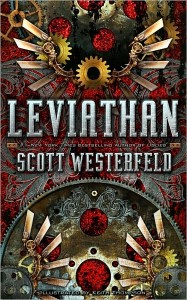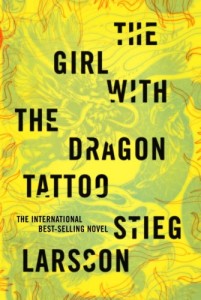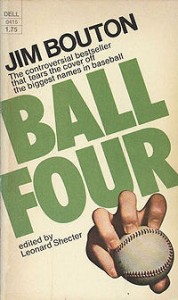Leviathan by Scott Westerfeld (Simon Pulse, 2009)
I started off my summer with this young adult title from last year. I had heard a lot of good press about this book, and had seen it prominently displayed in Woodland’s library/media center. Written by the author of the acclaimed Uglies series, this novel imagines a world where World War I is fought not between the Central and the Allied powers, but rather between the Clankers and the Darwinists. The Clanker countries (Germany, Austria-Hungary, the Ottomans, etc.) use all sorts of menacing steam-punk machinery and weapons to fight their battles. The Darwinists (France, Britain, Russia. etc.) use fantastical biologically engineered animals in their everyday lives, as well as in their war, for in this alternate 1914, Charles Darwin and his disciples have been perfecting DNA manipulation for almost half a century. The Leviathan of the title is a great white whale that floats with hydrogen, and is used as a flying warship.
had seen it prominently displayed in Woodland’s library/media center. Written by the author of the acclaimed Uglies series, this novel imagines a world where World War I is fought not between the Central and the Allied powers, but rather between the Clankers and the Darwinists. The Clanker countries (Germany, Austria-Hungary, the Ottomans, etc.) use all sorts of menacing steam-punk machinery and weapons to fight their battles. The Darwinists (France, Britain, Russia. etc.) use fantastical biologically engineered animals in their everyday lives, as well as in their war, for in this alternate 1914, Charles Darwin and his disciples have been perfecting DNA manipulation for almost half a century. The Leviathan of the title is a great white whale that floats with hydrogen, and is used as a flying warship.
The story alternates between the two main characters: Aleksandar Ferdinand, the (fictional) orphaned son of the assassinated Archduke Franz Ferdinand, on the run from those who killed his parents; and Deryn Sharp, a Scottish commoner who disguises herself as a boy in order to join the British Air Service. Their paths eventually convene, as the war explodes onto the world stage. The point of view of the story continually alternates back and forth between Aleksandar and Deryn, even after their paths coincide late in the story. The action is briskly paced, and takes place in a wholly realized and imagined alternate world, where enemies are divided by their respective faiths in machinery or altered nature. However, as is the trend in YA literature, this book is only the first of a series, so there is no real resolution in this novel.
Leviathan book trailer
The Girl With The Dragon Tattoo by Stieg Larsson (Knopf, 2009 (U.S.))
Much like the rest of the world, I fell under the spell of the late Stieg Larsson’s icy thriller, originally  published in Sweden in 2005, after the author’s death. Disgraced financial writer Mikael Blomkvist, facing three months of jail time after being set up on a libel charge, is summoned to a remote island community by retired Swedish millionaire business magnate, Henrik Vanger, who offers Blonkvist an unusually proposition: if the writer helps Vanger with a 40 year old unsolved disappearance of his niece Harriet, Vanger will give him the evidence Blomkvist needs to clear his name.
published in Sweden in 2005, after the author’s death. Disgraced financial writer Mikael Blomkvist, facing three months of jail time after being set up on a libel charge, is summoned to a remote island community by retired Swedish millionaire business magnate, Henrik Vanger, who offers Blonkvist an unusually proposition: if the writer helps Vanger with a 40 year old unsolved disappearance of his niece Harriet, Vanger will give him the evidence Blomkvist needs to clear his name.
As Blomkvist works through a harsh Swedish winter, he enlists the help of Lisbeth Salander, an enigmatic, antisocial, tattooed and pierced computer hacker and world class investigator. Emotionally damaged, Salander eventually begins to befriend and trust Blomkvist, and together, they work to uncover an increasingly bizarre family criminal mystery.
Expertly paced and brilliantly suspenseful, with one of the most original female characters in contemporary literature, believe the hype: this book refuses to be put down until it is completed.
The Girl With The Dragon Tattoo
Steinbrenner: The Last Lion of Baseball by Bill Madden (Harper, 2010)
Coming just about two months before his death, this definitive biography of George Steinbrenner, the principal owner of the New York Yankees since 1973, provides a welcome antidote to the recent revisionist history of Steinbrenner’s loose cannon ownership of the most famous franchise in sports. Spanning Steinbrenner’s nearly four decades as baseball’s most (in)famous owner, Madden details Steinbrenner at his worst (his impetuous firing of manager after manager until Joe Torre’s wildly successful run from 1996 until 2007; his petty and sometimes cruel treatment of employees) and his best (determinedly building of the Yankees into a dynasty; his quiet support of many charities, including New York’s Silver Shield Foundation). Madden, a veteran baseball reporter for the New York Daily News, relied on his thirty-odd years of friendship with Steinbrenner, as well as access to recently unearthed daily recordings of Gabe Paul, Steinbrenner’s first president of the Yankees. The result is a stranger-than-fiction account of the last of a his kind owner, and the dynasty that he built in the South Bronx.
George Steinbrenner’s Greatest Moments
Ball Four by Jim Bouton (World Publishing Co., 1970)
Finally, continuing with a baseball theme during these waning dog days of summer, I finally got around to reading a book that I’ve been meaning to read for a long time – Jim Bouton’s classic baseball diary, Ball Four. I came across a hardcover edition of the book from 1970 at a used book sale, and decided that it was high time that I read this book. Written by Jim Bouton, who came up in the early 1960s as a winning pitching with the New York Yankees, Ball Four documents Bouton’s 1969 season with the expansion Seattle Pilots, who only existed for that one season, before becoming the Milwaukee Brewers in 1970. His arm recovering from injury, Bouton documents his attempts to regain some of his earlier success as a relatively older (31 ) pitcher, trying to master a new pitch (the inscrutable knuckle ball). However, Bouton also documented the boozing, brawling,carousing, cursing, and locker hijinks he witnessed with the Pilots and with the heralded Yankees. While these stories nary raise an eyebrow in our era of Deadspin.com and ESPN News, back in 1970, Bouton’s book was seen as anathema by the commissioner to the writers and down to the players, who clung to the old mantra “What you see here, what you say here, what you do here, let it stay here.” Bouton’s book even earned him a 28 year exile from Yankee Stadium, ended finally on Old Timers Day in 1998.
becoming the Milwaukee Brewers in 1970. His arm recovering from injury, Bouton documents his attempts to regain some of his earlier success as a relatively older (31 ) pitcher, trying to master a new pitch (the inscrutable knuckle ball). However, Bouton also documented the boozing, brawling,carousing, cursing, and locker hijinks he witnessed with the Pilots and with the heralded Yankees. While these stories nary raise an eyebrow in our era of Deadspin.com and ESPN News, back in 1970, Bouton’s book was seen as anathema by the commissioner to the writers and down to the players, who clung to the old mantra “What you see here, what you say here, what you do here, let it stay here.” Bouton’s book even earned him a 28 year exile from Yankee Stadium, ended finally on Old Timers Day in 1998.
More than just a tell-all book about baseball, Bouton’s book provides a thoughtful reflection on triumphs and fears of an athlete who is not sure if he can still play this game. It is also an insight into why baseball hold such a grip on men, young and old.


















